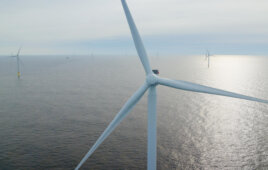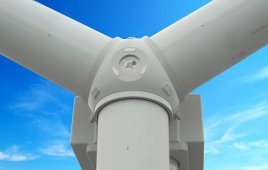Microgrids fit multiple classifications of energy sources independent from or in addition to grid-tied energy providers. They are independent electrical grids that can either run on energy generated from non-grid-tied sources like wind turbines, solar panels or diesel generators; or microgrids act as a backup power solution in the event of a grid outage. Microgrids are often used in resiliency applications, where electrical grid outages can otherwise leave an off-taker vulnerable, physically or financially.
For grid-tied, developed communities (those with established roadways and highway systems), municipalities can have regulations for structure heights and may require a turbine be built a specified distance from residences. This was the case for state utility Ameren Illinois who constructed a microgrid on a property adjacent to The University of Illinois in Champaign, Illinois. The company installed a 167-ft., 100-kW turbine in the microgrid project, meeting Champaign’s mandate requiring the structure to not be built taller than 175 ft. or within 1,000 ft. of a residential customer.

Ameren Illinois installed a 100-kW wind turbine at its microgrid project on a piece of property neighboring the University of Illinois. Ameren Illinois
Ameren Illinois’s microgrid, or Technology Application Center, at the University of Illinois, was constructed to determine how different distributed energy resources would affect the electric distribution system. The microgrid is composed of a wind turbine, photovoltaic solar and a diesel generator, and integrated with Champaign’s electrical grid.
For wind to be a viable power source for a microgrid, an energy storage component is recommended.
“Wind doesn’t blow all the time — it’s intermittent. So, problems can develop because the wind changes speed and direction all the time,” said Rod Hilburn, manager of the Technology Application Center (TAC) with Ameren Illinois. “It’s not constant. You’re not burning coal and you don’t have hydro that’s keeping the turbine spinning at a nice constant pace. Those are some things that we’re trying to research. “
Installing a megawatts-large wind project as a microgrid would require a companion battery to store excess energy generation. The Ameren microgrid is considered a utility project, but its wind generation is far less than a multiple-turbine wind farm. Scaling storage to that size of energy generation can prove difficult but will be necessary if wind plans to be more viable in microgrid applications.
From an economic standpoint, the cost-benefit of a microgrid is on a case-by-case basis, but reliability can be a significant decider, Hilburn said.
“If you have customers who have processing inside their plants that require extreme levels of reliability…you end up having a mess that the costs of cleaning up may outweigh the premium cost you have in order to put the microgrid into place, he said.”

Ameren Illinois’s utility-scale microgrid was constructed to determine how different distributed energy resources would affect the electric distribution system. Ameren Illinois
Many existing microgrids are deployed in underdeveloped regions that don’t have access to an established electrical grid or road infrastructure. Diesel generators and smaller wind turbines have been a standard for these off-grid applications.
“Wind turbines have gotten larger, multi-megawatt-sized, and there’s actually a void in the market between the great big and the very small wind turbines,” said Matt Carter, president and CEO, Carter Wind Energy. “This is exactly where we see microgrids and the need for medium-sized turbines. That’s where the industry is. That’s why they overlook this microgrid market because they’re focused on large wind farms or what I call developed economies and developed infrastructure.”
A limiting factor for utility-scale wind projects trying to break into remote communities is accessibility. Hauling the components of a utility-scale turbine to an undeveloped region poses limitations in infrastructure critical to construction. The cement machinery required to pour a foundation and the cranes for installing turbines cannot always access these regions easily. And a megawatts-large wind farm could produce more energy than needed in that setting.
“Think about if you ever had any maintenance that you have to do on the wind turbine. You have to bring out another crane to do that work in the Lower 48 [states] or in developed regions where there’s roads and all this infrastructure,” Carter said.
Carter Wind Energy’s product solution for this accessibility issue is a self-erecting wind turbine that doesn’t require a crane for installation and uses a guide tower to reduce the cement required for a foundation. Diesel generators are popularly used in remote microgrid applications, and a case study by Northern Power claims wind power costs a third of diesel to operate. In addition, turbines occupy less space than an average power plant.
“It doesn’t matter what the cost is, many of these microgrids that are operating and using diesel — expensive diesel — they can’t use wind because there’s just not the equipment there to install it and maintain it,” Carter said.
Filed Under: Featured, Projects




